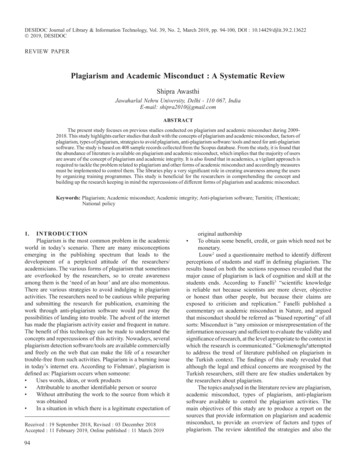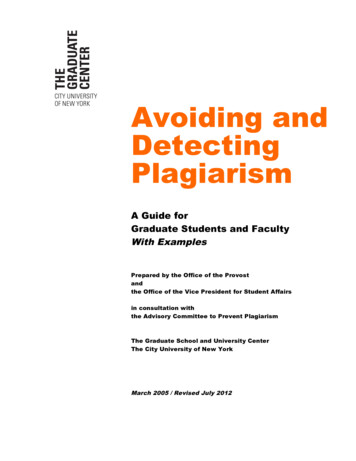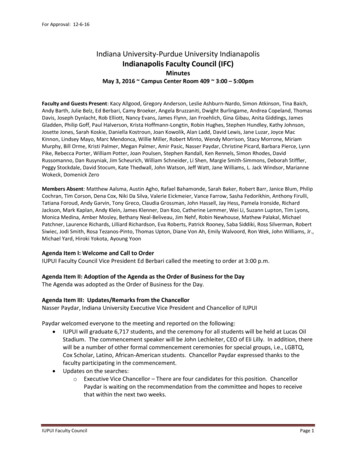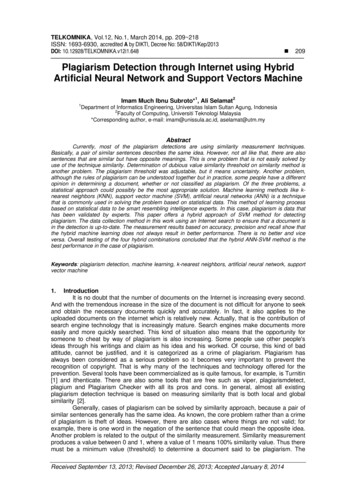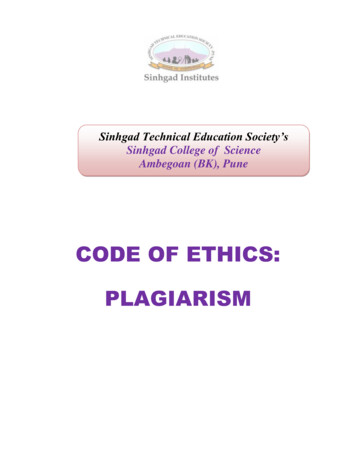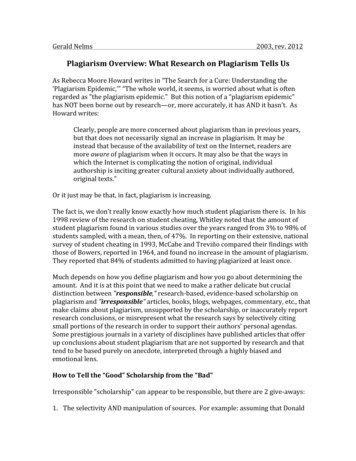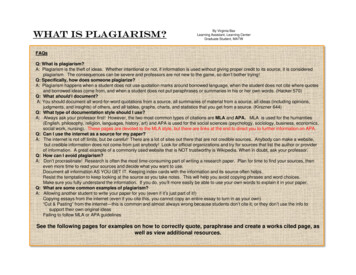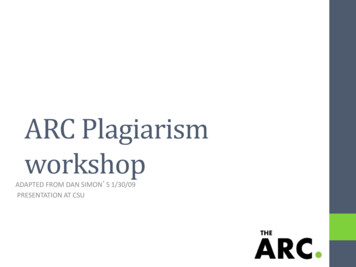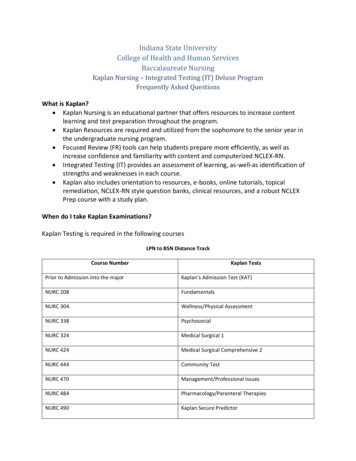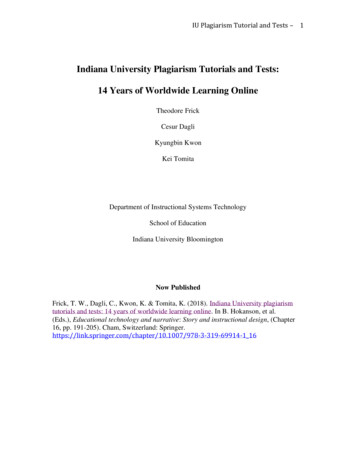
Transcription
IU Plagiarism Tutorial and Tests – 1Indiana University Plagiarism Tutorials and Tests:14 Years of Worldwide Learning OnlineTheodore FrickCesur DagliKyungbin KwonKei TomitaDepartment of Instructional Systems TechnologySchool of EducationIndiana University BloomingtonNow PublishedFrick, T. W., Dagli, C., Kwon, K. & Tomita, K. (2018). Indiana University plagiarismtutorials and tests: 14 years of worldwide learning online. In B. Hokanson, et al.(Eds.), Educational technology and narrative: Story and instructional design, (Chapter16, pp. 191-205). Cham, Switzerland: /978-3-319-69914-1 16
IU Plagiarism Tutorial and Tests – 2AbstractWe briefly tell our story about the Indiana University Plagiarism Tutorials and Tests(IPTAT), from the original design and development in 2002 through 2016. Widespreadcheating on the Certification Test in 2012-13 required us to redesign the test. Thechanges resulted in a structure that offered billions and trillions of test combinations forundergraduate and graduate students. These more difficult tests indicated a need forimproving the tutorial and for incorporation of First Principles of Instruction. Next webriefly illustrate how each principle was implemented. Finally, we summarize usage ofthe redesigned IPTAT in 2016 and empirical findings on instructional effectiveness.Keywords: plagiarism tutorial, student learning assessment, instructional design, studentcheating, first principles of instruction, MOOC, online instruction, online testing,instructional effectiveness.
IU Plagiarism Tutorial and Tests – 3Early Years: 2002 – 2015The tutorial and test on How to Recognize Plagiarism was originally developed for useby students in the Instructional Systems Technology (IST) department at Indiana University,starting in September, 2002. As other instructors and students have since discovered theseonline resources on the web, and by word of mouth, tutorial and test usage has beenincreasing each year.Figure 1. Home page of the original tutorial, circa 2003.Usage of the tutorial has been increasing almost exponentially. See Figure 2.
IU Plagiarism Tutorial and Tests – 4IPTAT Annual Page 0Figure 2. Annual page views (i.e., total web requests) of the Indiana University PlagiarismTutorial and Tests, 2003 through 2016.Throughout the 14 years of design, development, modification, and usabilitytesting, the plagiarism tutorial design team has consisted of a variety of members. Werefer to the changing group as the plagiarism tutorial design team in telling our story. Alink to the major contributors is provided at:https://www.indiana.edu/ academy/firstPrinciples/credits.html.The plagiarism tutorial and tests have undergone numerous changes over theyears. To simplify matters, we refer here to the IPTAT: Indiana University PlagiarismTutorials and Tests. The current version of IPTAT is located at:https://www.indiana.edu/ academy/firstPrinciples/index.html.The design team has learned through correspondence initiated by instructors thatmany now require their students to take this test. We have no control over who uses our
IU Plagiarism Tutorial and Tests – 5tests and for what purposes. Our goal is to help people understand what plagiarism is, sothat they do not commit plagiarism in their writing and presentations. At this time,anyone is welcome to use our learning resources and tests for free.Aside from minor corrections and modifications, the original tutorial and 10-itemtest remained largely the same between 2002 and 2012.Recent Improvements in the Plagiarism Tutorial and TestsBased on feedback the design team has received from college and high schoolinstructors whose students use our online tutorial, we describe major changes between2013 and 2015. Users normally contact us by clicking on a link provided at the bottom ofnearly every web page in the tutorial. This link goes to a simple web form to complete,and when submitted sends e-mail to a hidden address, which we monitor regularly. Thisprimary feedback loop with users, combined with web logs on tutorial access, providesimpetus for making changes to improve the tutorial and tests.Defeating the cheating: Major changes in 2013Several instructors had sent e-mail in 2013 who were highly concerned about thevalidity of the 10-item test in the IPTAT. They suspected widespread cheating was goingon, and thus certificates granted were highly questionable. They provided a link to aYouTube video, where the answer key was contained in the video. The creator of thatvideo also mocked the test as a useless waste of time, initially posted in late 2012.In mid-July, 2013, Frick changed the order of the 10 test items and renumberedthem. Within a few days, comments posted below the YouTube video indicatedfrustration that the answer key no longer worked. A new post subsequently provided thenew answer key, followed by further comments expressing gratitude.
IU Plagiarism Tutorial and Tests – 6A week later, the test items were scrambled again, and within 24 hours, a newanswer key was posted. After several more repetitions of this pattern, Frick decided thatsomething different was needed. Meanwhile, access to the YouTube video literallydoubled by mid-August and kept increasing daily as the fall semester began.Developing a better test. The plagiarism tutorial design team met and planned forhow to minimize this kind of cheating. First, a much larger item pool needed to bedeveloped. Second, a PHP script was necessary to present items in a random order, judgethe answers, and provide feedback. This was accomplished in about 3 weeks, andimplemented in early September. There were now billions of unique combinations of 10item tests.Not surprisingly, the design team received a lot of e-mail from students whocomplained about “how hard” the test was, and also from instructors who were unawareof the sudden changes and who had told their students about the previous test. So thedesign team added explanations on the website which informed users of the changes.Defeating test answer guessing and use of the ‘Back’ button. A further strategyfor passing a test that had been in use (even before the new randomized tests) was to justguess answers to the 10 items, to get feedback on the numbers of right and wronganswers. Then a student would click the ‘Back’ button in their web browser, change ananswer, resubmit their test for evaluation, and get further feedback on the number of rightanswers. Basically, through this trial-and-error strategy, students could improve theirresults until they passed. In fact, the design team already knew about this strategy, whichwas confirmed by examination of web logs on test attempts and passing rates.
IU Plagiarism Tutorial and Tests – 7The solution to this problem was not simple. Once a web page is accessed via auser’s web browser, that page is cached locally on their device. When the ‘Back’ buttonis clicked, the browser just displays the cached page and does not need to make a newrequest for the page on the website. Scripting a solution to this problem was extremelyvexing. Even JavaScript code did not solve the problem, because all a user had to do wasto turn off JavaScript in their web browser. This ‘cat-and-mouse’ game continuedbetween the design team and student users. The motivation for passing a test and earninga certificate was largely due to instructors who required their students to present theircertificates for credit in classes they were taking. And students apparently were lessinterested in learning about plagiarism than they were about finding an easy way to gettheir assignment completed without spending a lot of time.The ultimate solution to the problem involved creation of unique test IDsassociated with each test attempt. It also required storing a unique file (on the web hostsite) for each test attempt that contained the sequence of test items and the number ofcorrect answers whenever someone failed a test. Thus, if the ‘Back’ button strategy wasattempted, the PHP script would check to see if a file existed with the unique test ID withthe exact sequence of test items attempted. If so, no further feedback was provided. Thatuser’s only option was to take a new test, with 10 new questions randomly selected fromthe large pool.This solution created a very large number of unique test attempt files on thewebsite host, and further required a daily maintenance strategy. Literally, as many as3,000 new files were created daily during peak usage times. To prevent very large
IU Plagiarism Tutorial and Tests – 8numbers of files accumulating rapidly, a Linux ‘crontab’ job was automatically run atmidnight to remove each day’s new files.A further strategy students used to cheat was via collaboration. One studentwould pass a randomized 10-item Certification Test, and receive the customizedcertificate sent to him or her. Then another student would use the same computer, clickthe ‘Back’ button several times, enter their unique information (name and e-mailaddress), click the ‘Submit’ button, and receive their own certificate without taking andpassing a new test. The design team confirmed this by viewing the web log ofcertificates granted, where the design team would see a sequence of certificates withdifferent student names and e-mail addresses, but with identical time stamps, IP numbers,dates, and test durations. There was not much the design team could do about this at thetime, other than warn instructors to look out for certificates that were the same except forthe students’ names (the IPTAT had inserted IP numbers, etc. on each certificate).One indicator of our success in defeating the kinds of cheating described abovewas the number of complaints the design team was receiving from students who wereunable to pass a test, and who were “sure” that the testing system was broken. Our stockanswer was that the tests were operating properly, and asked whether or not they haddone any of the tutorial and practice tests. Most of the time, the design team just ignoredthese complaints.After implementing these changes early in 2013 fall semester, the design teamalso received more e-mail from college and high school instructors who were gettingcomplaints from their students about the new tests. Many instructors were unaware of
IU Plagiarism Tutorial and Tests – 9the changes the design team had recently made. The design team added a link to the webpage that described the changes, dates made, and reasons why.A few highly frustrated students did e-mail us who said they completed the entiretutorial and passed 10-20 practice tests, but they still were not able to pass an IPTATCertification Test. Practice tests were similar to Certification Tests but included specificfeedback on right and wrong answers, unlike Certification Tests that only indicatedwhether or not a test was passed.Overall, the most frequent complaint was: “Why don’t you tell us which questionswe missed and why? How are we supposed to learn from the test?” And the design teamknew from web logs that the tutorial pages were accessed relatively infrequently incomparison to the astronomical numbers of test attempts. Students apparently wereconvinced that if they tried enough times, they would eventually pass. This is not true.They must take time to learn from the tutorial. The design team also knew from web logsof test attempts that the passing rate was under 10%. The design team also could observelogs in real time, where the same IP number was repeated in succession over a shortperiod of time, resulting in failures until that individual passed a test.Improving instructional feedback from a test: Major changes in 2014The biggest problem that remained with the new 10-item tests, selected at randomfrom a large inventory, was that feedback after failing a test was not helpful to students.Starting in fall 2013, the IPTAT no longer told them which questions were answeredcorrectly and which were missed. This was done on purpose in order to protect the testitem pool and to minimize cheating via use of answer keys that were prevalent in thepast. From our perspective, the tests were much more valid than previously. From a
IU Plagiarism Tutorial and Tests – 10student perspective, the tests were “too hard”. The IPTAT was violating theirexpectations for feedback by not telling them about their mistakes and how to correctthem. From their perspective, the IPTAT was providing poor instruction, or worse, thatthe instructional designers were incompetent, lousy teachers. A frequent question: “Whydoes it [the IPTAT] not tell me how many questions I missed and what the right answersare, so I can learn from the test?”Identifying patterns of plagiarism. The solution for providing better feedbackwithout compromising the item pool and to discourage cheating was by identifyingpatterns of plagiarism in the test for undergraduate and high school students. Frickidentified 15 different patterns of plagiarism, in addition to 2 patterns of non-plagiarism.See: https://www.indiana.edu/ academy/firstPrinciples/plagiarismPatterns/. Each itemin the inventory was coded as to type of plagiarism. Each pattern was given a catchyname such as: “clueless quote”, “crafty cover-up”, “devious dupe”, “severed cite”, etc.).New web pages were developed for each pattern. Each pattern page provided aprototypical example illustrating the pattern, a detailed explanation of why it isplagiarism, and very importantly modeled how to fix the plagiarism.This solution not only provided many more examples as part of the tutorial, butalso gave us a way to provide better feedback if a Certification Test was not passed.While the IPTAT still did not provide specific feedback on which questions were missed,it instead provided feedback on the types of mistakes being made. This wasaccomplished by providing one or more links to respective patterns of plagiarism on webpages during test feedback. If a pattern was repeated in the test, only one link wasprovided. In general, students could roughly guess how many items were missed
IU Plagiarism Tutorial and Tests – 11according to how many pattern links were provided in Certification Test feedback, but itwas not an exact count. In a randomly selected 10-item test it was very likely that one ormore patterns would be repeated.The consequence of this improvement in Certification Test feedback was todouble the passing rate, from about 8% to 15% at the time this change was implemented.Creating separate tests for graduate students. As part of his dissertation research,Andrew Barrett (2015) created a new, even larger item pool designed for master’s anddoctoral level students. His dissertation, available online in ProQuest, describes his workin detail. This test was administered on a different web site. Test length was not fixed,but depended on adaptive testing algorithms for computerized classification testing.Thus, items were presented one at a time, unlike the undergraduate and advanced highschool student tests, which each consisted of 10 randomly selected questions presentedon a single web page.Feedback on the graduate-level test was different also. Instead of identifyingpatterns of plagiarism, this test indicated how many questions were missed according tofailure to identify plagiarism when it was in fact word-for-word, when it wasparaphrasing, and failure to identify non-plagiarism when in fact it was.For the graduate-level Certification Test, users complained that, on rare occasionsan error occurred, abruptly terminating their test with no feedback, and requiring them tostart a new test. After numerous efforts to trace and correct this problem, the design teamconcluded that it was likely dependent on the device and web browser being used (oftencorrected by changing their device or restarting it), or a session timeout occurred becauseof too long a time interval between answering one question and the next.
IU Plagiarism Tutorial and Tests – 12Certification Test registration added in 2015Registration for the Certification Test for undergraduate and high school studentswas implemented in August, 2015. This made it easier for test takers to retrieve theircertificates by later logging in with their e-mail address and password created duringregistration. Furthermore, registration before taking a test made it no longer possible toreceive spoofed certificates via collaboration and use of the ‘Back’ button. Informationentered when registering (name and e-mail address) could no longer be changed after atest was passed. Finally, a spoofed certificate could not be validated as legitimate.Instructors could also view certificates, as before, by entering the unique test IDprovided by the test taker, and either the IP address or user e-mail address to confirm thevalidity of the certificate.One surprising and interesting finding: about 5% of users had difficultyregistering because of errors in their e-mail address. Part of the registration processrequired them to confirm their identity by going to their e-mail account, open themessage sent from the IPTAT, and then click on a link that returned them to the IPTAT.This also explained why some users in the past never received their certificates forpassing—they mistyped their e-mail address! And then blamed the IPTAT for failing tosend them the certificate they had worked so hard to earn.A detailed list of the history of changes to improve the IPTAT is provided at:https://www.indiana.edu/ academy/firstPrinciples/recentChanges.html .
IU Plagiarism Tutorial and Tests – 13Major Redesign of IPTAT in 2015The design team redesigned the IPTAT for several reasons: First and foremost, thedesign team wanted to improve the effectiveness of the tutorial. The new designimplemented First Principles of Instruction (Merrill, 2002; 2013). Merrill (2002) hadclaimed that—regardless of specific content, teaching methods, or programmatic subjectmatter—student learning would be promoted to the extent that each of the FirstPrinciples is implemented in design of instruction. In addition to using First Principles,the design team wanted to carry out research to evaluate how these five principles ofinstruction affect student learning. In particular, is Merrill’s claim supported byempirical evidence on student usage of parts of the IPTAT and successful learning asindicated by passing a Certification Test?First Principles include:1. Provision of authentic tasks or problems, sequenced from simple to complex,2. Activation to help students connect what they already know with what is to benewly learned,3. Demonstration of what is to be learned,4. Application, where students try to do the tasks or solve problems with instructorguidance and feedback, and5. Integration of what is learned into students' own lives.A variety of pedagogical methods can be used to implement each principle, depending onthe types of learning objectives, content being taught, and levels of schooling(elementary, secondary, postsecondary). See Merrill (2013) for in-depth description andnumerous examples of First Principles of Instruction.
IU Plagiarism Tutorial and Tests – 14The redesign process took place over a period of about 9 months, with the bulk ofthe development and production completed in late 2015.Authentic problems principleThis required us to design a series of authentic problems in recognizingplagiarism, arranged from simple to complex. We did so, as indicated on the menu at:https://www.indiana.edu/ academy/firstPrinciples/tutorials/index.html. As can be seen inFigure 4, problems are arranged at 5 levels of difficulty in recognizing plagiarism: basic,novice, intermediate, advanced, and expert. At each level of difficulty, we provideactivation, demonstration, application, integration, and a practice test.Figure 4. Five levels of difficulty in recognizing plagiarism.Activ
IU Plagiarism Tutorial and Tests – 3 Early Years: 2002 – 2015 The tutorial and test on How to Recognize Plagiarism was originally developed for use by students in the Instructional Systems Technology

